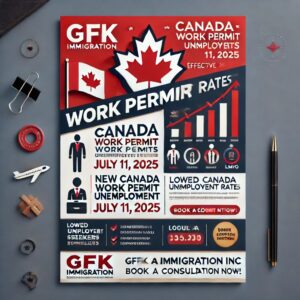
New Canada Work Permit Unemployment Rates Effective July 11
On July 11, 2025, Canada’s federal government released its latest quarterly update to unemployment rates for Census Metropolitan Areas (CMAs), reshaping the Temporary Foreign Worker Program (TFWP).
Effective from July 11 to October 9, 2025, low-wage Labour Market Impact Assessments (LMIAs) will not be processed in 20 CMAs where unemployment rates are 6% or higher.
This will be impacting thousands of employers and foreign workers.
Whether you’re a business owner relying on the TFWP or a foreign worker seeking a Canadian work permit, this change is revolutionary.
Let’s explore the updated list of affected regions, analyze the implications, and provide actionable strategies to navigate this evolving landscape.
Table of Contents
What’s Happening with Canada’s Work Permit Policies?
The Labour Market Impact Assessment (LMIA) is a critical document for Canadian employers hiring foreign nationals under the TFWP.
It ensures that hiring foreign workers doesn’t harm job opportunities for Canadians.
Since September 26, 2024, the government has tightened restrictions on the low-wage stream, refusing LMIA applications in CMAs with unemployment rates of 6% or higher.
Without an LMIA, employers cannot hire foreign workers for low-wage roles, and existing TFWP workers cannot renew their permits in these areas.
The July 11, 2025, update identifies 20 CMAs where low-wage LMIAs are blocked until October 9, 2025.
This article dives into the updated unemployment rates, highlights affected regions, and offers practical advice for employers and workers.
The Latest Unemployment Rates: Which CMAs Are Affected?
The July 11, 2025, update provides unemployment rates for Canada’s CMAs—urban areas with populations of at least 100,000, including a core of 50,000 or more.
Below is the complete list of CMAs where low-wage LMIA applications are blocked from July 11 to October 9, 2025, with comparisons to previous quarters:
| Census Metropolitan Area | Unemployment Rate (%) (July 11–Oct 9, 2025) | Unemployment Rate (%) (Apr 4–Jul 10, 2025) | Unemployment Rate (%) (Jan 10–Apr 3, 2025) |
|---|---|---|---|
| St. John’s, Newfoundland and Labrador | 7.2 | 7.6 | 6.0 |
| Halifax, Nova Scotia | 6.2 | 4.8 | 4.6 |
| Moncton, New Brunswick | 6.4 | 5.4 | 5.4 |
| Saint John, New Brunswick | 7.4 | 7.7 | 6.1 |
| Fredericton, New Brunswick | 6.2 | 6.9 | N/A* |
| Montréal, Quebec | 6.9 | 6.7 | 6.2 |
| Ottawa-Gatineau, Ontario/Quebec | 6.4 | 5.3 | 5.4 |
| Kingston, Ontario | 7.2 | 7.2 | 5.7 |
| Belleville – Quinte West, Ontario | 7.1 | 5.6 | N/A* |
| Peterborough, Ontario | 9.9 | 9.9 | 4.5 |
| Oshawa, Ontario | 9.2 | 8.0 | 7.5 |
| Toronto, Ontario | 8.9 | 8.6 | 7.9 |
| Hamilton, Ontario | 6.6 | 7.3 | 6.3 |
| St. Catharines-Niagara, Ontario | 6.4 | 7.7 | 6.2 |
| Kitchener-Cambridge-Waterloo, Ontario | 6.9 | 8.5 | 7.3 |
| Brantford, Ontario | 6.8 | 7.2 | 4.2 |
| London, Ontario | 6.9 | 5.5 | 6.4 |
| Windsor, Ontario | 11.0 | 9.3 | 8.8 |
| Barrie, Ontario | 7.3 | 7.5 | 6.0 |
| Nanaimo, British Columbia | 7.3 | 6.0 | N/A* |
| Vancouver, British Columbia | 6.3 | 6.6 | 5.9 |
| Chilliwack, British Columbia | 6.3 | 5.9 | N/A* |
| Kamloops, British Columbia | 8.7 | 7.1 | N/A* |
| Calgary, Alberta | 7.3 | 7.8 | 7.5 |
| Edmonton, Alberta | 7.6 | 7.3 | 6.8 |
Note: N/A indicates the CMA wasn’t listed in the unemployment rate table for those periods.
Key Insights from the Updated Unemployment Data
-
- Fewer Affected CMAs: The number of CMAs with unemployment rates of 6% or higher has decreased from 24 to 20. Notably, Abbotsford-Mission (6.1%), Guelph (5.9%), and Kelowna (5.0%) have dropped below the 6% threshold, allowing low-wage LMIA processing to resume in these areas.
-
- New Additions: Halifax (6.2%), Moncton (6.4%), Ottawa-Gatineau (6.4%), and London (6.9%) have crossed the 6% threshold, joining the restricted list this quarter.
- Significant Unemployment Spikes: Windsor, Ontario, saw a sharp increase to 11.0% from 9.3%, reflecting severe economic challenges in the region. Oshawa (9.2%) and Peterborough (9.9%) also remain among the highest.
- Improvements in Some Regions: Calgary (7.3% from 7.8%), Hamilton (6.6% from 7.3%), and St. Catharines-Niagara (6.4% from 7.7%) saw declines, though they remain above the 6% cutoff.
- Eligible CMAs: Regions like Victoria (4.1%), Saskatoon (4.6%), and Québec City (4.1%) have unemployment rates below 6%, making them prime targets for low-wage LMIA applications.
The data is updated quarterly in January, April, July, and October, reflecting real-time economic shifts.
The July 11 update shows a mixed picture: while some regions are recovering, others face persistent or worsening unemployment.
Why This Matters: The Broader Context of Canada’s Labour Market
New Canada Work Permit Unemployment Rates Effective July 11
The LMIA restrictions are part of Canada’s strategy to address economic challenges in 2025, including post-pandemic recovery, inflation, and housing shortages.
Here’s the bigger picture:
-
- Protecting Local Workers: The 6% unemployment threshold prioritizes Canadian workers in regions with high unemployment, such as Windsor (11.0%) and Toronto (8.9%), where job losses in manufacturing and tech persist.
- Redistributing Labour Demand: By allowing low-wage LMIAs in rural areas and Census Agglomerations, the government encourages hiring outside urban centres. This could stimulate rural economies but risks labour shortages in cities.
- Economic Pressures: Inflation and housing shortages are straining urban areas, where high unemployment exacerbates social challenges. The TFWP restrictions aim to reduce pressure on infrastructure and services.
- Immigration Reforms: The 2025–2027 Immigration Levels Plan, announced October 24, 2024, caps TFWP work permits at 82,000 annually and aims to reduce temporary residents from 7% to 5% of Canada’s population by 2026.
- Public Debate: Critics warn of labour shortages in sectors like hospitality and retail, while supporters argue the policy protects Canadian jobs and prevents wage suppression.
Implications for Employers: Navigating the New Rules
The July 11 update poses challenges for employers in the 20 affected CMAs, where low-wage LMIA applications are blocked.
Here’s what businesses need to know:
Challenges for Employers
-
- Hiring Restrictions: In CMAs like Windsor (11.0%), Toronto (8.9%), and Edmonton (7.6%), low-wage LMIA applications are refused, forcing reliance on local talent.
- Permit Expiry Issues: TFWP workers in affected CMAs cannot renew low-wage permits, risking workforce disruptions.
- Increased Costs: Raising wages to meet the high-wage stream threshold (20% above the provincial median since November 8, 2024) increases labour costs.
- Sector-Specific Impacts: Hospitality, retail, and food services face significant hurdles in urban centres.
Workarounds for Employers
-
- Switch to High-Wage Stream: Offer wages at or above the provincial median plus 20%. For example:
- British Columbia: Median $28.85/hour, high-wage threshold $34.62/hour.
- Ontario: Median $28.39/hour, high-wage threshold $34.07/hour. This bypasses the 6% restriction but requires budget adjustments.
- Switch to High-Wage Stream: Offer wages at or above the provincial median plus 20%. For example:
-
- Leverage Exempt Sectors: Exemptions apply to:
- Primary agriculture (e.g., farm workers)
- Food processing (e.g., meat processing)
- Healthcare (e.g., nurses)
- Construction (e.g., labourers)
- In-home caregiving for high medical needs. Highlight these exemptions in LMIA applications.
- Target Eligible Regions: Shift hiring to CMAs with unemployment below 6%, such as Victoria (4.1%), Saskatoon (4.6%), or Québec City (4.1%), or to rural Census Agglomerations.
- Leverage Exempt Sectors: Exemptions apply to:
- Wait for the Next Update: Monitor CMAs with borderline rates, like Vancouver (6.3%) or Hamilton (6.6%), for potential eligibility on October 10, 2025.
- Enhance Local Recruitment: Prioritize hiring Canadians, permanent residents, and underrepresented groups (e.g., youth, Indigenous workers) to meet TFWP requirements.
Implications for Foreign Workers: What You Need to Know
For foreign workers, the update could disrupt job searches or permit renewals. Here’s how it impacts you:
Challenges for Workers
- Permit Expiry Risks: If your low-wage TFWP permit expires in an affected CMA, you cannot renew it and must stop working unless your employer secures a high-wage LMIA or relocates you.
- Limited Job Opportunities: Job offers in high-unemployment CMAs like Windsor (11.0%) or Toronto (8.9%) won’t qualify for low-wage LMIAs.
- Economic Instability: Permit expiries could lead to financial challenges, particularly in urban centres.
Strategies for Foreign Workers
- Target Low-Unemployment CMAs: Focus on regions like:
- Victoria, British Columbia (4.1%): Tourism and service roles.
- Saskatoon, Saskatchewan (4.6%): Agriculture and logistics.
- Québec City, Quebec (4.1%): Tech and public administration.
- Guelph, Ontario (5.9%): Manufacturing and education.
- Negotiate with Employers: Request a wage increase to meet the high-wage threshold or a transfer to an eligible CMA.
- Explore Exempt Sectors: Seek jobs in agriculture, healthcare, or construction, which are exempt from the ban.
- Apply for a Visitor Record: If your permit expires, apply for a visitor record to stay in Canada while exploring options like the International Mobility Program (IMP) or permanent residency.
- Monitor Trends: Check the October 10, 2025, update for potential eligibility in borderline CMAs like Vancouver (6.3%).
Urban vs. Rural Divide
By restricting low-wage LMIAs in urban CMAs but allowing them in rural areas, the government aims to redistribute labour demand.
This could boost rural economies but risks urban labour shortages in sectors like hospitality.
What’s Next for Canada’s Labour Market?
New Canada Work Permit Unemployment Rates Effective July 11
The July 11 update raises critical questions:
- Will urban labour shortages worsen? Sectors like hospitality in Toronto and Vancouver may struggle.
- Will foreign workers leave? Stricter rules could push workers to other countries.
- Can rural areas handle demand? Infrastructure in smaller regions may face strain.
- Will exemptions hold? High unemployment could lead to tighter restrictions.
The October 10, 2025, update will be crucial. Falling unemployment could reopen low-wage LMIAs in key CMAs, while rising rates could expand restrictions.
GFK Immigration
Gboyega Esan RCIC R708591
Phone: +1 (647) 225-0092
#CanadaPR #Citizenship #GFKImmigrationExperts #studyincanada #Steinbach #canada #Alberta #studyinaustralia #ielts #studentvisa #studyinusa #studyvisa #immigration #canadavisa #visa #education #internationalstudents #overseaseducation #study #canadaimmigration #ExpressEntry
